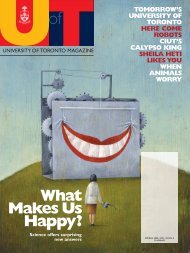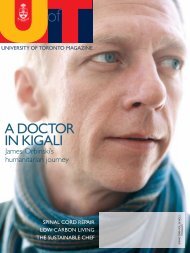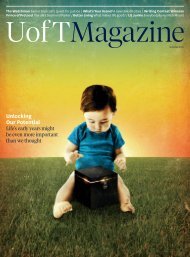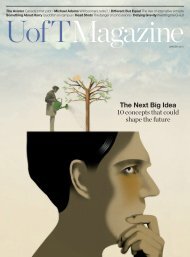What's the solution to Toronto's traffic problems? - University of ...
What's the solution to Toronto's traffic problems? - University of ...
What's the solution to Toronto's traffic problems? - University of ...
You also want an ePaper? Increase the reach of your titles
YUMPU automatically turns print PDFs into web optimized ePapers that Google loves.
President’s Message<br />
Serendipi<strong>to</strong>us Circumstances<br />
The Toron<strong>to</strong> region is a great home<br />
for a global university<br />
THROUGH THE CENTURIES, universities and <strong>the</strong>ir <strong>to</strong>wns or cities<br />
have sometimes progressed in parallel, and sometimes<br />
not. The <strong>University</strong> <strong>of</strong> Toron<strong>to</strong> has been very lucky in this<br />
geographic lottery, and continues <strong>to</strong> benefit from <strong>the</strong> development<br />
<strong>of</strong> <strong>the</strong> Toron<strong>to</strong> metropolitan region.<br />
Regional growth has yielded an outstanding and everexpanding<br />
pool <strong>of</strong> local applicants. It also drove <strong>the</strong> creation<br />
<strong>of</strong> our east and west campuses in <strong>the</strong> 1960s, leading in turn<br />
<strong>to</strong> more choices for our students and U <strong>of</strong> T’s unique<br />
regional academic system. The arrival <strong>of</strong> an extraordinary<br />
number <strong>of</strong> immigrants has made our campuses a diverse<br />
mirror <strong>of</strong> <strong>the</strong> region and <strong>the</strong> world. Moreover, we’ve benefited<br />
from partnerships with outstanding hospitals, cultural<br />
institutions, municipalities, social agencies and a huge array<br />
<strong>of</strong> inves<strong>to</strong>r-owned and non-pr<strong>of</strong>it enterprises alike.<br />
These regional opportunities – academic and o<strong>the</strong>rwise –<br />
and <strong>the</strong> diversity <strong>of</strong> <strong>the</strong> region have helped <strong>the</strong> university<br />
attract faculty, staff and students from across Canada and<br />
around <strong>the</strong> world. In turn, <strong>the</strong> university’s global prominence<br />
arguably adds lustre <strong>to</strong> <strong>the</strong> metropolitan Toron<strong>to</strong> region.<br />
Synergy between academic institutions and <strong>the</strong>ir regions<br />
is nothing new. We see it, for example, in <strong>the</strong> emergence <strong>of</strong><br />
Silicon Valley. Students and faculty at Stanford and Berkeley<br />
are certainly part <strong>of</strong> that success s<strong>to</strong>ry. Perhaps surprisingly,<br />
Toron<strong>to</strong> has also emerged as a globally recognized innovation<br />
hub. The region places fourth in <strong>the</strong> OECD for entrepreneurship,<br />
and recently was ranked fourth worldwide for startups<br />
in information and communications technology. It hasn’t<br />
hurt one bit <strong>to</strong> have three U <strong>of</strong> T campuses in <strong>the</strong> region. In<br />
2011 alone, <strong>the</strong> university itself spawned 25 new companies.<br />
And thousands <strong>of</strong> our remarkable alumni throughout <strong>the</strong><br />
region are leaders in <strong>the</strong> Toron<strong>to</strong> startup revolution.<br />
This spring, addressing <strong>the</strong> Toron<strong>to</strong> Board <strong>of</strong> Trade,<br />
I acknowledged our geographic good fortune and shared<br />
some evidence <strong>of</strong> it. Among <strong>the</strong> statistics: Toron<strong>to</strong> is <strong>the</strong><br />
third-largest financial and digital media centre and <strong>the</strong><br />
fourth-largest health sciences and biotechnology cluster in<br />
North America. Fur<strong>the</strong>rmore, even a conservative estimate<br />
shows that <strong>the</strong> Toron<strong>to</strong> region contributes more <strong>to</strong> Canada’s<br />
GDP in percentage terms than what New York, Chicago and<br />
Bos<strong>to</strong>n combined contribute <strong>to</strong> <strong>the</strong> United States’ GDP.<br />
But those numbers are only part <strong>of</strong> a larger and more<br />
complex s<strong>to</strong>ry. The Toron<strong>to</strong> region’s outsized clout reflects<br />
consistent multi-sec<strong>to</strong>r strength. And that strength doesn’t<br />
simply add up. Through cross-sec<strong>to</strong>r convergence, it has<br />
multiplicative or synergistic effects.<br />
The Toron<strong>to</strong> design sec<strong>to</strong>r – <strong>the</strong> third-largest in North<br />
America – provides a telling example. More than 28,000<br />
designers work in <strong>the</strong> region. The design sec<strong>to</strong>r depends<br />
on strengths in information and communications technology,<br />
marketing and advertising, product development,<br />
and <strong>the</strong> creative and cultural industries. And <strong>of</strong> course, great<br />
design drives success in <strong>the</strong>se areas. Once again, it’s about<br />
convergence.<br />
The same could be said <strong>of</strong> your university. As I’ve written<br />
elsewhere, Toron<strong>to</strong> is one <strong>of</strong> a handful <strong>of</strong> universities in<br />
<strong>the</strong> world consistently ranked as <strong>to</strong>p-tier across all major<br />
disciplines. This characteristic – coupled with <strong>the</strong> curiosity<br />
and creativity <strong>of</strong> our faculty and students – facilitates interdisciplinary<br />
synergy. It’s a terrific asset for education as<br />
well as scholarship and research.<br />
How can <strong>the</strong> <strong>University</strong> <strong>of</strong> Toron<strong>to</strong> amplify this success<br />
In my view, we need <strong>to</strong> build more national and international<br />
networks. Regions and institutions are only as good<br />
as <strong>the</strong>ir partners. This is part <strong>of</strong> a modern Copernican<br />
revolution: away from <strong>the</strong> zero-sum game <strong>of</strong> “brain drain”<br />
versus “brain gain,” and in<strong>to</strong> <strong>the</strong> new world <strong>of</strong> “brain chains”<br />
– interlocking jurisdictions that are stronger <strong>to</strong>ge<strong>the</strong>r. It’s<br />
multiplicative convergence again: this time in terms <strong>of</strong> populations,<br />
cultures and perspectives. And in this task, we<br />
are extraordinarily fortunate <strong>to</strong> have a distinguished alumni<br />
community stretching from sea <strong>to</strong> sea <strong>to</strong> sea in Canada,<br />
and spanning over 170 countries around <strong>the</strong> world.<br />
There are different versions <strong>of</strong> <strong>the</strong> old tale <strong>of</strong> <strong>the</strong> three<br />
princes <strong>of</strong> Serendip. What <strong>the</strong> versions have in common are<br />
<strong>the</strong> importance <strong>of</strong> <strong>the</strong> princes’ education, a narrative <strong>of</strong><br />
travel and return, and <strong>the</strong> enduring influence on human<br />
affairs <strong>of</strong> simple good fortune. We truly have serendipi<strong>to</strong>us<br />
circumstances – and hope that, wherever you live or travel,<br />
you will continue <strong>to</strong> regard <strong>the</strong> <strong>University</strong> <strong>of</strong> Toron<strong>to</strong>’s three<br />
campuses as a second home.<br />
Sincerely,<br />
David Naylor<br />
6 www.magazine.u<strong>to</strong>ron<strong>to</strong>.ca PHOTO: © 2011 GUSTAVO TOLEDO PHOTOGRAPHY

















